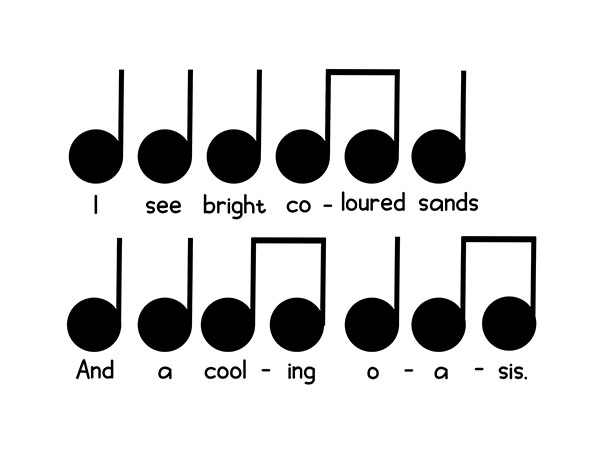Rhythm, beat and repetition in picture books assists with developing communication, phonological awareness, syllabification, and fluency.
I watched a show about autism and women a couple of years ago and a lot of buttons went click, click, click.
Each click provided a reason for how I think, act and process. It explained why I am who I am.
As with everything I do, I went over the top. I purchased several books about women and autism, then started reading. Notebook in hand, as I read a list started building – and building – and building. Off to the doctor went I. After glancing through my notes, she believed I am one of those thousands of undiagnosed women. Wanting to know for sure, I commenced the process of finding out, but Covid popped up and things went no further.
You may be asking, what does this have to do with rhythm?
For me, rhythm – and through association, beat and repetition – is an inherent need that keeps me grounded when events become overpowering sensory wise.
Even today, I will often ‘come to’ and find myself rocking or my legs swinging back and forth as I watch tv. I believe it’s to do with subconsciously maintaining a constant rhythm and beat that in turn calms the senses.
For as long as I can remember, music has been an integral part of my life. My mum often tells the story of how she would enter the lounge room to find me immersed in listening and dancing to classical music on the radio. I was only 3 or so at the time and had figured out how to turn to the classical station.
Although classical still resides close to the top of the list, today it’s Enya that I return to time and time again during those times of stress. Her rhythm, tempo, beat, tone, and harmonies draw me in, calming my brain, thoughts, and muscles.
For those times when I feel a bit down, it’s country music by artists such as Johnny Cash, Dolly Parton, and Troy Cassar-Daley.
The old-time rock and roll or artists such as Boney M, Abba, Olivia Newton John, and Cliff Richard are perfect when I am in just the right spot.
From the moment we are conceived, we are surrounded by rhythm, beat and repetition – it’s innate in us. A mum’s heartbeat heard and felt within the womb and the blood pumping through our bodies, whilst voices, music and other sounds permeate into the unborn child’s world. Later, it’s the pounding of waves upon a beach, bird songs, our feet as they walk, run or jump. Life is filled with rhythm, beat and repetition. I believe this is why we as a race feel such connection to music and rhythmic stories.
Like music, language, itself, has rhythm. When listening to the best speakers, or storytellers, it’s their beat, rhythm and cadences that hold an audience’s attention. They are the ones you remember – David Attenborough, Brian Cox and Tim Winton – all have it.
The art of storytelling incorporates the same elements as music. It’s not so surprising to learn research has discovered that rhythm helps with the development of the brain. In tandem with beat, it assists with the development of language – its patterns, intonations, tempo, and constructions.
As a young child I loved books written by Dr Seuss and the good old nursery rhymes, whilst down the track my classes – and me, too – fell in love with stories like Lynley Dodd’s Hairy Maclary. Their rhythm, rhyme and beat make the tales so much fun. They are playful and sure to remain in the memory banks for decades to come.
Since commencing my journey in writing children’s books, I have come to realize that I speak in a rhythmic cadence. It’s why my stories all have a rhythmic flow and beat. To not have it, is all wrong for me. No matter how hard I try, I cannot create a non – rhythmic story.
When writing it feels like I am creating pieces of music. Some contain the equivalent of an introduction, verse, chorus, and finale. Others are beautiful rhythmic rhyming stories, while the occasional story commences gently like the sea, gradually building to a crescendo before returning to a gentle rhythmic finish.
The sequel to A Big Blue Boat is the perfect example of rhythm and beat used within storytelling. The story could be put to music, but unfortunately, I failed dismally at musical theory. A reader can clap the beat or the rhythm as they read.
If notated, this is what the first line would look something like this.

Why Are Stories With Rhythm, Beat & Repetition So Important?
Children’s literacy skills commence through speaking and listening. It’s by playing with sounds, rhythm, and the beat that young children start to understand the ways in which language works, and how to use it. Playing as they do makes it fun.
When teaching, I quickly realized the children with little exposure to nursery rhymes, finger games, and rhythmic stories experienced the most difficulties making the connections required to read and write. Themes centred around nursery rhymes, fairytales, and authors who wrote in a rhythmic style often formed part of my classroom theme at the beginning of the school year.
Like music, rhythmic language in picture books helps develop the neural pathways – those networks that allow us to connect to, and interact with, the world around us. Rhythm, beat and repetition in picture books assist with developing communication, phonological awareness, syllabification, and fluency. These are the skills that assist children in learning to read and write. Like music, rhythmic stories have tone and expression. They help children learn to speak with tone, cadence and expression in a fun way.
An example of this is found in the story I have just completed and intend to publish next. Below is one of the verses found in the text. Each verse has the same number of syllables, thereby creating a repetitive rhythm and beat. Although the words change with each verse, the actual rhythm doesn’t. This will assist the young reader as they continue building those neural connections and strengthen their understanding of how language works. The illustrations will complete the text, as they show the images for the unknown vocabulary.

Rhythm provides a pattern in the way that words are formed and put together. No matter the language, there is always a set order to be used.
Because rhythm, beat and repetition are so innate within us, the stories containing these structures call to us. Nursery rhymes, finger games and rhythmic stories – such as the ‘Cat in the Hat’ and Hairy Maclary’ – have these structures utilized to perfection. This is why they are so popular. It’s why children ask for them time and time again. Little do they know, they are also learning about language and the way it fits together. These stories help with developing those intrinsic skills. With them, children can follow the patterns of sound that enable language development.
Repetition often goes hand in glove with rhythmic stories and rhymes and assists the strengthening of those pathways. This also helps with the pronunciation of words and the development of memory.
Rereading itself, is a form of repetition. I can’t remember how many times I reread my rhythmic stories as a child. I did this because they continued calling me back. Children in the classes I taught also had their favourite books. They requested these time and time again. Many parents believe revisiting books isn’t important, but it is. Rereading continues strengthening those neural connections AND it assists with creating a fluency of language – spoken, read, and written.
In closing, here is a list of great rhythmic stories.
Hairy Maclary
Goldilocks and the Three Bears
The Enormous Turnip
Jack and the Beanstalk
The Gingerbread Man
The Cat in the Hat
Hop on Pop
The Foot Book
The Smallest Turtle
Lynley Dodd
Dr Seuss
Dr Seuss
Dr Seuss
Lynley Dodd
Giraffes Can’t Dance
Giles Andrea and Guy Parker-Rees
Where is the Green Sheep?
Commotion in the Ocean
Bad Dad Moves
We’re Going on a Bear Hunt
The Very Cranky Bear
How to Hide an Octopus
Seashells by the Seashore
Mem Fox
Giles Andreae
Jacob Eckerberger
Michael Rosen
Nick Bland
Ruth Heller
Marianne Berkes
Usborne Illustrated Nursery Rhymes
Felicity Brooks
Over in the Ocean on a Coral Reef
Marianne Berkes
Three Little Fishies
Josephine Carringer & Bernice idins. Music: Saxie Dowell
Over In The Meadow
Katherine Floyd Dana (Olive A Wadsworth)
There’s a Hippopotamus on our Roof Eating Cake
Hazel Edwards
Chicka Chicka Boom Boom
Bill Martin Jr, John Archambault, Lois Ehlert
Rhyming is often found in rhythmic stories.
https://suseaspray.com/why-is-rhyming-important-in-the-early-years/

